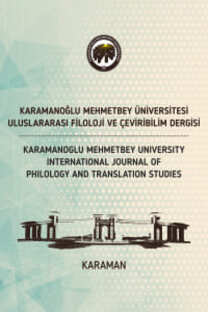IRKSAL AYRIMLARI MEKANSAL AÇIDAN ANLAMAK: SELVON, KUREISHI VE ADEBAYO'DAN LONDRA'DA SİYAH OLMAK
UNDERSTANDING RACIAL DIVISIONS IN SPATIAL TERMS: SELVON, KUREISHI AND ADEBAYO ON BEING BLACK IN LONDON
London, city, identity, cultural diversity, immigrants, racism,
___
- Adebayo, Diran. (1996/1997). Some Kind of Black. London: Abacus. Ahrens, Lisa. (2019). The Transformative Potential of Black British and British Muslim Literature: Heterotopic Spaces and the Politics of Destabilisation. Bielefeld: Transcript Verlag. Bhabha, Homi K. (1994). The Location of Culture, London: Routledge. Bromley, Roger. (2000). Narratives for a New Belonging: Diasporic Cultural Fictions. Edinburgh: Edinburgh University Press. Câmpu, Adina. (2010). The Question of Identity in Diran Adebayo’s “Some Kind of Black”. Bulletin of the Transilvania University of Braşov. 3, 52, 57-62. Cuevas, Susanne. (2008). Babylon and Golden City: Representations of London in Black and Asian British Novels since the 1990s. Heidelberg: Universitätsverlag Winter. Foucault, Michel. (1984). Of Other Spaces, Heterotopias. Trans. from Architecture, Mouvement, Continuité no. 5, 46-49. https://foucault.info/documents/heterotopia/foucault.heteroTopia.en/ Freeman, Nicholas. (2007). Conceiving the City: London, Literature, and Art 1870-1914. Oxford: Oxford University Press. Hall, Stuart. (1987). Minimal Selves. Identity - The Real Me: Postmodernism and the Question of Identity. London: Institute of Contemporary Arts. Hammond, Andrew. (2007). The Hybrid State: Hanif Kuresihi and Thatcher’s Britain. Joel Kuortti and Jopi Nyman (Editors). Reconstructing Hybridity: Post-Colonial Studies in Transition (p. 221-240). Amsterdam: Radopi. Kureishi, Hanif. (1986). My Beautiful Laundrette and The Rainbow Sign. London: Faber and Faber. Kureishi, Hanif. (1990). The Buddha of Suburbia. London: Faber and Faber. MacCabe, Colin. (2004). Interview: Hanif Kureishi on London. Critical Quarterly, 41, 3, 37-56. doi:10.1111/j.0011-1562.1999.00248.x McLaughin, Joseph. (2000). Writing the Urban Jungle: Reading Empire in London from Doyle to Eliot. The University Press of Virginia. McLeod, John. (2004). Postcolonial London: Rewriting the Metropolis. London: Routledge. Moore-Gilbert, Bart. (2001). Hanif Kureishi. Manchester: Manchester University Press. Ponzanesi, Sandra and Merolla, Daniela. (2005). Introduction. Sandra Ponzanesi and Daniela Merolla (Editors). Migrant Cartographies: New Cultural and Literary Spaces in Post-Colonial Europe (p. 1-52). Oxford: Lexington Books. Procter, James. (2004). Stuart Hall. London: Routledge. Richards, David. (2010). Framing Identities. Shirley Chew and David Richards (Editors). A Concise Companion to Postcolonial Literature (p. 9-28). West Sussex: Blackwell. Schwarzbach, F.S. (1979). Dickens and the City. Bristol: The Athlone Press University of London. Selvon, Sam. (1956/2006). The Lonely Londoners. Penguin Books. Thomas, Susie. (2011). Hanif Kureishi: 'The Buddha of Suburbia' – 1990. https://www.londonfictions.com/hanif-kureishi-the-buddha-of-suburbia.html Stein, Mark. (2004). Black British Literature: Novels of Transformation. Ohio: Ohio State University Press. Wohlsein, Barbara. (2008). Englishmen Born and Bred: Cultural Hybridity and Concepts of Englishness in Hanif Kureishi’s The Buddha of Suburbia and Zadie Smith’s White Teeth. Saarbrucken: VDM Verlag Dr. Muller.
- Yayın Aralığı: Yılda 2 Sayı
- Başlangıç: 2018
- Yayıncı: Karamanoğlu Mehmetbey Üniversitesi
ÇEVİRİBİLİMDE YERELLEŞTİRME PARADGİMASINA DOĞRU
KONFUÇYÜS VE ÇİN FELSEFESİNİN TEMELLERİ
HASAN ALİ TOPTAŞ’IN UYKULARIN DOĞUSU ROMANINDA ZAMAN VE DÖNGÜSEL YAPI
IRKSAL AYRIMLARI MEKANSAL AÇIDAN ANLAMAK: SELVON, KUREISHI VE ADEBAYO'DAN LONDRA'DA SİYAH OLMAK
ÇİN MODERN EDEBİYATI DENEME ESERLERİ SEÇKİSİ
دراسة صيغة الفعل في تفسير البيضاوي: نماذج مختارة من حاشية الشهاب وحاشية القونوي
Emad ALY, Ahmet Hamdi CAN, Betül CAN
TİYATRO METNİ ÇEVİRİSİNDE ANLAM KURAMI SÜREÇLERİ: SAHTE SIRDAŞLAR ÖRNEĞİ
SANATSAL BİR BİÇİM OLARAK GROTESK NEDİR?
